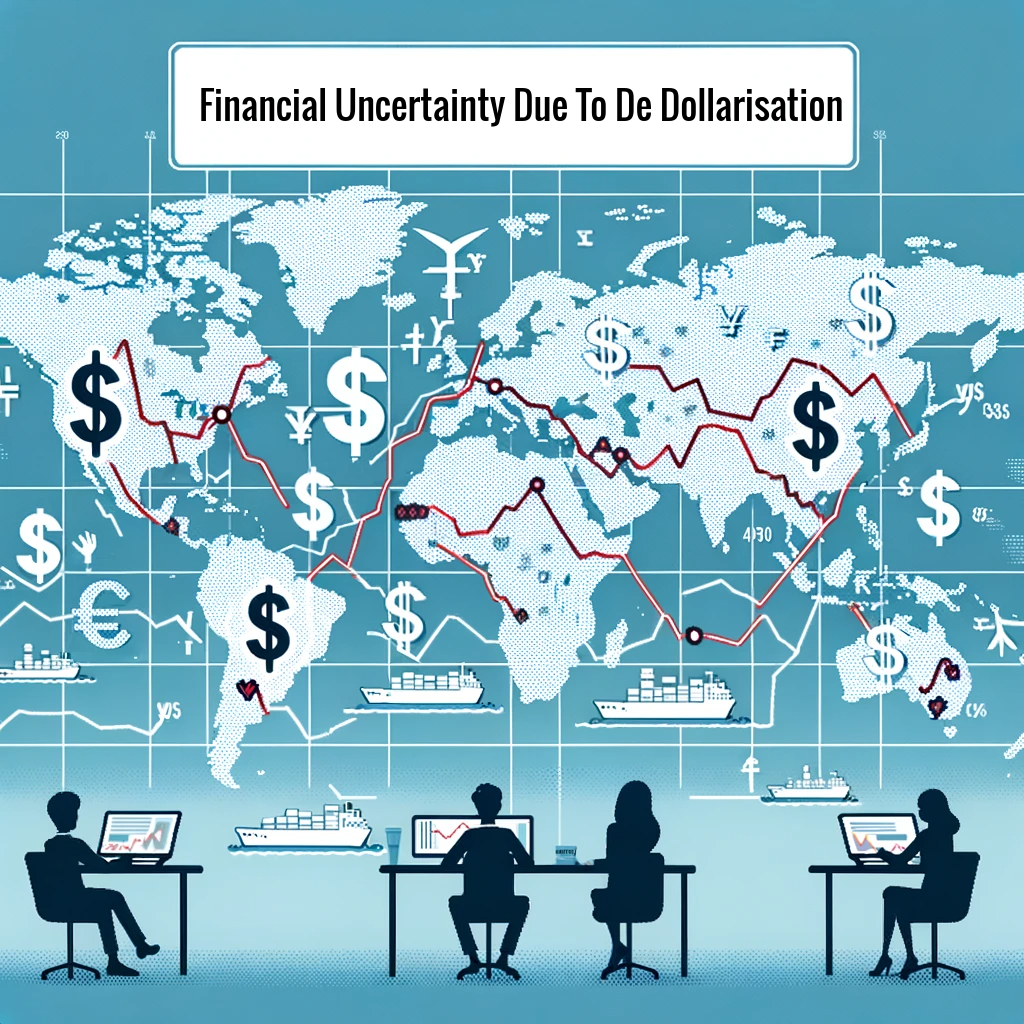Digital Zeitgeist – The Tipping Point: De-Dollarisation Dilemma in Global Trade Fuels Financial Uncertainty
Introduction: In a world intricately woven by complex financial systems, the recent disruptions in payment mechanisms for oil trades between India and Russia spotlight a significant shift – the crumbling dominance of the U.S. dollar. This situation has escalated due to geopolitical tensions, notably the U.S. and EU’s sanctions on Russia following its Ukraine invasion, and the resultant price caps on Russian oil. These events are not solitary; they echo the growing global sentiment favouring de-dollarisation. However, this shift doesn’t come without its perils and complexities, as evident from the ongoing payment conundrum involving the yuan, dirhams, and rupees.
The Crux of Currency Conundrum: At the heart of this quagmire is India’s apprehension over utilising the Chinese yuan to settle its oil dues with Russia. While geopolitical undercurrents following the Indo-China border tensions in 2020 partly fuel this reluctance, there’s an overarching narrative at play. The increasing avoidance of the U.S. dollar in international trade, stemming from geopolitical rifts and sanctions, is forcing nations to explore alternatives. However, these alternatives, as the Indian situation reveals, are not free from geopolitical, financial, and strategic implications.
A Reuters report from October 16 highlights how the Indian government’s stance has led to a payment logjam for at least seven oil cargoes from Russia. This standoff hasn’t deterred the supply chain, though, with India rising as the top importer of Russian seaborne oil this year, taking advantage of discounts offered after the West’s sanctions on Moscow.
The Yuan Factor: The encumbrance in employing yuan, as detailed by finance ministry officials, reflects the intricate dance between economic pragmatism and political expediency. While not explicitly banned, the use of the yuan is neither encouraged, elucidating the tacit apprehensions entangling currency choices with foreign policy and national sentiment, especially post the 2020 border skirmishes.
It’s not just a political tussle; financial implications are evident. Indian refiners note an additional 2-3% cost for transactions in yuan due to the double conversion necessity, first to Hong Kong dollars and then to yuan. This “extra layer,” as sources cite, is a financial burden, underscoring the complex interplay of economics in the de-dollarisation narrative.
De-Dollarisation: A Growing Global Tide: This episode is a fragment of a larger mosaic. De-dollarisation – the global drift away from the U.S. dollar in international trade – has been gaining momentum. Russia and China have been forefront in this charge, diminishing their reliance on the dollar due to escalating geopolitical tensions with the U.S. and in response to sanctions.
According to a report by the Nikkei Asia, Russia’s National Wealth Fund slashed its dollar holdings to zero in June 2021. Meanwhile, China has been promoting the internationalisation of the yuan vigorously, a move corroborated by the People’s Bank of China’s white paper on its digital currency in July 2021, highlighting cross-border yuan transactions.
Rippling Consequences of De-Dollarisation: This seismic shift from the dollar could have profound implications for global financial stability:
- Volatility and Economic Cost: As the Indian scenario illustrates, transacting in non-dollar currencies can incur additional conversion costs, potentially disrupting trade equations and inducing market volatility.
- Geo-political Realignments: Currency is a facet of sovereignty and geopolitical power. Preferring one over another can signal geopolitical realignments. For instance, India’s hesitation in using the yuan underscores not just economic, but strategic, diplomatic, and security considerations.
- Reserve Currency Repercussions: The dollar’s status as the world’s primary reserve currency is under scrutiny. A potential decline could disrupt global markets, impacting interest rates, investments, and economic stability worldwide.
- Sanction Side-Effects: As countries like Russia and Iran circumvent U.S. sanctions by eschewing the dollar, the efficacy of economic sanctions as a tool of foreign policy comes under question, potentially leading to more direct confrontational stances.
- Emerging Currencies: There’s an opening for other currencies, like the euro or the yuan, to bolster their standing in international trade. However, this multipolarity in reserve currencies could lead to further economic fragmentation and competition.
Conclusion: Global Economic & Financial System Consequences: The current Indo-Russian oil payment gridlock exemplifies the burgeoning global financial system’s fissures as de-dollarisation gains pace. The shift towards a multipolar currency world is fraught with uncertainty, potential market instabilities, and geopolitical repercussions.
The immediate economic implications, such as increased transaction costs and market volatility, are just the tip of the iceberg. The broader, more profound consequences lie in potential shifts in global power structures, the uncertain future of economic sanctions’ efficacy, and the stability of the international financial system.
The challenge for global leaders lies in navigating this uncharted territory with sagacity, ensuring that economic pragmatism doesn’t fan geopolitical conflicts. Moreover, international cooperation and dialogue will be paramount in steering the global economy through these tumultuous waters, highlighting the need for multilateralism in an increasingly polarised world.
The de-dollarisation wave is not just a financial phenomenon; it’s a geopolitical pivot, the reverberations of which will shape the new world order. In this context, nations’ decisions, influenced by a mix of economic, political, and strategic factors, will dictate the global financial landscape’s evolution in the coming years. Vigilance, adaptability, and cooperation will be the guiding stars in this intricate constellation of global finance.
Disclaimer: The views and opinions expressed in this article are those of the author and do not necessarily reflect the official policy or position of GPM-Invest or any other organisations mentioned. The information provided is based on contemporary sourced digital content and does not constitute financial or investment advice. Readers are encouraged to conduct further research and analysis before making any investment decisions.

